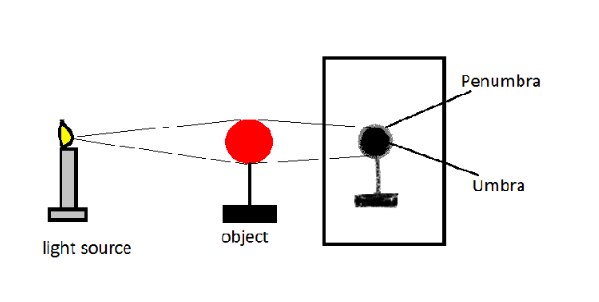
What do you mean by the term Umbra?
Answer
489.9k+ views
1 likes
Hint:The term Umbra is used to describe the types of shadow. So we are going to explain the formation of shadows and their classification on the basis of their characteristics. We will also know about the eclipse in the solar system under different shadows.
Complete step by step solution:
When an object is placed between a light source and any type of screen, then we get the shadow of the object we used. If the light source is dim (as a mobile torch), then the formed shadow we get is dark and spread broadly on screen. But we used high resolution LED light bulb, we get more clear shadow which is seem to divided in two parts-
1) Umbra
2) Penumbra
Umbra and penumbra are the main parts of a shadow. The darkest part of shadow is called Umbra and the lighter and partial dark part at the edges of shadow is called penumbra.
Umbra- When light falls on any object then a shadow of this object will form at the screen behind the object. The size of this shadow depends on the position of the object with respect to the light source. If an object is placed near the light source, then we get the larger shadow of the object and if the object is placed far from source then the shadow formed will be small.
In this shadow the darkest part in the middle of the shadow is called umbra. The umbra is the maximum part of any shadow by which we can get an idea about the shape and size of an object.

Additional information:
Penumbra- The partial dark part of shadow at the edges of it, is called penumbra. It can be seen clearly by using a high resolution light source.
Note- These umbra and penumbra are also formed in the solar system by the revolution motion of the Earth and the Moon. The different eclipses lie in this region of umbra and penumbra under the sunlight. As a total solar eclipse, total lunar eclipse and partial lunar eclipse are formed in the umbra region. And partial solar and lunar eclipse forms in the penumbra section.
Complete step by step solution:
When an object is placed between a light source and any type of screen, then we get the shadow of the object we used. If the light source is dim (as a mobile torch), then the formed shadow we get is dark and spread broadly on screen. But we used high resolution LED light bulb, we get more clear shadow which is seem to divided in two parts-
1) Umbra
2) Penumbra
Umbra and penumbra are the main parts of a shadow. The darkest part of shadow is called Umbra and the lighter and partial dark part at the edges of shadow is called penumbra.
Umbra- When light falls on any object then a shadow of this object will form at the screen behind the object. The size of this shadow depends on the position of the object with respect to the light source. If an object is placed near the light source, then we get the larger shadow of the object and if the object is placed far from source then the shadow formed will be small.
In this shadow the darkest part in the middle of the shadow is called umbra. The umbra is the maximum part of any shadow by which we can get an idea about the shape and size of an object.

Additional information:
Penumbra- The partial dark part of shadow at the edges of it, is called penumbra. It can be seen clearly by using a high resolution light source.
Note- These umbra and penumbra are also formed in the solar system by the revolution motion of the Earth and the Moon. The different eclipses lie in this region of umbra and penumbra under the sunlight. As a total solar eclipse, total lunar eclipse and partial lunar eclipse are formed in the umbra region. And partial solar and lunar eclipse forms in the penumbra section.
Latest Vedantu courses for you
Grade 9 | CBSE | SCHOOL | English
Vedantu 9 CBSE Pro Course - (2025-26)
School Full course for CBSE students
₹37,300 per year
Recently Updated Pages
Master Class 10 Science: Engaging Questions & Answers for Success

Master Class 10 Social Science: Engaging Questions & Answers for Success

Master Class 10 Maths: Engaging Questions & Answers for Success

Master Class 10 English: Engaging Questions & Answers for Success

Class 10 Question and Answer - Your Ultimate Solutions Guide

Master Class 9 General Knowledge: Engaging Questions & Answers for Success

Trending doubts
Give 10 examples of unisexual and bisexual flowers

Draw a labelled sketch of the human eye class 12 physics CBSE

Differentiate between homogeneous and heterogeneous class 12 chemistry CBSE

Differentiate between insitu conservation and exsitu class 12 biology CBSE

What are the major means of transport Explain each class 12 social science CBSE

What is the difference between resemblance and sem class 12 social science CBSE




